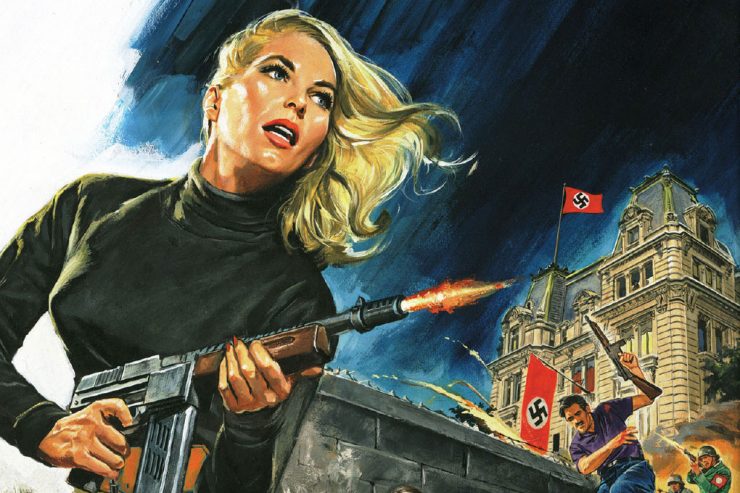 Although PulpFest was looking forward to welcoming artist’s model Eva Lynd to the DoubleTree by Hilton Hotel Pittsburgh – Cranberry in 2020, the coronavirus pandemic had other plans. So we’re very pleased to announce that the men’s adventure magazine supermodel has agreed to be our PulpFest 2021 guest of honor.
Although PulpFest was looking forward to welcoming artist’s model Eva Lynd to the DoubleTree by Hilton Hotel Pittsburgh – Cranberry in 2020, the coronavirus pandemic had other plans. So we’re very pleased to announce that the men’s adventure magazine supermodel has agreed to be our PulpFest 2021 guest of honor.
A frequent collaborator with Doc Savage model Steve Holland, our guest was born Eva Inga Margareta von Fielitz to Countess and Count Asti von Fielitz in 1937. She took the name Eva Lynd to further her acting career after emigrating to the United States in 1950.
In 1956, Eva began modeling for many of the top glamour girl photographers of the era — Peter Basch, Wil Blanche, Herb Flatow, Leo Fuchs, Emil Herman, Morris Kaplan, Charles Kell, Lester Krauss, Earl Leaf, Ed Lettau, Jerry Yulesman and others. Alluring photos of her appeared in dozens of men’s pinup magazines, bachelor magazines, and men’s adventure magazines. She also modeled for cover and interior photos published by true crime and detective magazines.
Eva was additionally — and still is — an actress. During the 1950s and 60s, she appeared in episodes of The Garry Moore Show, Peter Gunn, The Steve Allen Show, The Texan, and The Thin Man. In later years, she appeared in Hogan’s Heroes and Cagney & Lacey, as well as the cult movies, The Hypnotic Eye and That Lady from Peking. She has also been featured in various print ads and television commercials. Her latest was a commercial for Campbell’s Soup with her real-life husband, actor Warren Munson. However, Eva’s most remembered television role was as the “The Girl in the Tube,” the gorgeous woman who emerges seductively from a tube of Brylcreem in the classic and award-winning commercial.
If you’re a fan of vintage men’s adventure magazines, you may know that Eva Lynd was also a favorite model of artists Norm Eastman and Al Rossi, two of the top illustration artists who worked for the men’s adventure market.
Eastman used the model for dozens of his notorious “sweat magazine” cover paintings for men’s adventure magazines published by the Reese and Emtee companies. Most frequently in the artist’s paintings, Eva is one of the scantily-clad, distressed damsels being tormented by sadistic Nazis, evil Japanese, communists, bikers, or aboriginals. In some, she is a brave, gun-toting freedom fighter.
For Al Rossi, Eva modeled for men’s adventure magazine interior illustrations and for paperback covers. The artist — whose best-known work is probably the 1953 Ace Double paperback edition of William Burroughs’ Junkie — featured Eva on the covers to Orrie Hitt’s Women’s Ward, Florence Stonebreaker’s Summer Widow, and other paperbacks.
Both artists often had Eva pose with male artist’s model Steve Holland, whose face and image appeared in hundreds of paperback and magazine cover paintings, as well as interior illustrations. Holland is best known as the model that artist James Bama used for Doc Savage on the covers of the Bantam paperback series.
Please join us on Saturday, August 21, at PulpFest 2021 for “Eva Lynd — Countess, Actress, Model.” The men’s adventure magazine supermodel will be joined on the PulpFest stage by Bob Deis and Wyatt Doyle — publishers of the Men’s Adventure Library series. They’ll be discussing the process of modeling for cover illustrations and interior illustrations for the men’s adventure magazines and other publications. This should be of great interest to pop culture enthusiasts as the process would have been similar to the experiences of the models who posed for the pulp fiction magazines. They’ll also be discussing Eva’s working relationships with artists Norm Eastman and Al Rossi, as well as fellow model Steve Holland.
At PulpFest 2019, Bob Deis and Wyatt Doyle debuted an advance edition of Eva: Men’s Adventure Supermodel, specifically produced for the convention. A pictorial autobiography of Eva Lynd, the book features a cover painting by Norm Eastman. It was originally created for the December 1968 issue of New Man, published by Reese Publishing from 1963 through 1965 and Emtee Publications from 1965 through 1972. An adapted version of the painting is reproduced here, courtesy of The Rich Oberg Collection.
Many thanks to Bob Deis. His article, “(Re)Discovering Eva Lynd,” at the Idol Features website, was an invaluable resource for this post.







